MBA402 Risk Assessment Report: Trading.com Internal Risk Analysis
VerifiedAdded on 2023/06/03
|13
|3225
|318
Report
AI Summary
This report provides a comprehensive risk assessment of Trading.com, a fictional company offering share investment courses, using the risk exposure calculator framework. It examines pressure points related to growth (performance pressure, expansion rate, employee inexperience), culture (ri...

Running head: INTERNAL RISK MANAGEMENT
Internal Risk Management
Name of the Student
Name of the University
Author note
Internal Risk Management
Name of the Student
Name of the University
Author note
Paraphrase This Document
Need a fresh take? Get an instant paraphrase of this document with our AI Paraphraser

1
INTERNAL RISK MANAGEMENT
Table of Contents
Introduction:....................................................................................................................................2
A. Pressure points due to growth:....................................................................................................2
i) Pressure for performance:........................................................................................................3
ii) Rate of expansion:...................................................................................................................4
iii) Inexperience of key employees:.............................................................................................4
B. Pressure points due to culture:....................................................................................................5
i) Rewards for entrepreneurial risk taking:..................................................................................5
ii) Executive resistance to bad news:...........................................................................................6
iii) Level of internal competition:................................................................................................6
C. Pressure points due to information management:.......................................................................7
i) Transaction complexity and velocity:......................................................................................7
ii) Gaps in diagnostic performance:.............................................................................................8
iii) Degree of decentralized decision making:.............................................................................8
Conclusion:......................................................................................................................................9
References:....................................................................................................................................10
INTERNAL RISK MANAGEMENT
Table of Contents
Introduction:....................................................................................................................................2
A. Pressure points due to growth:....................................................................................................2
i) Pressure for performance:........................................................................................................3
ii) Rate of expansion:...................................................................................................................4
iii) Inexperience of key employees:.............................................................................................4
B. Pressure points due to culture:....................................................................................................5
i) Rewards for entrepreneurial risk taking:..................................................................................5
ii) Executive resistance to bad news:...........................................................................................6
iii) Level of internal competition:................................................................................................6
C. Pressure points due to information management:.......................................................................7
i) Transaction complexity and velocity:......................................................................................7
ii) Gaps in diagnostic performance:.............................................................................................8
iii) Degree of decentralized decision making:.............................................................................8
Conclusion:......................................................................................................................................9
References:....................................................................................................................................10
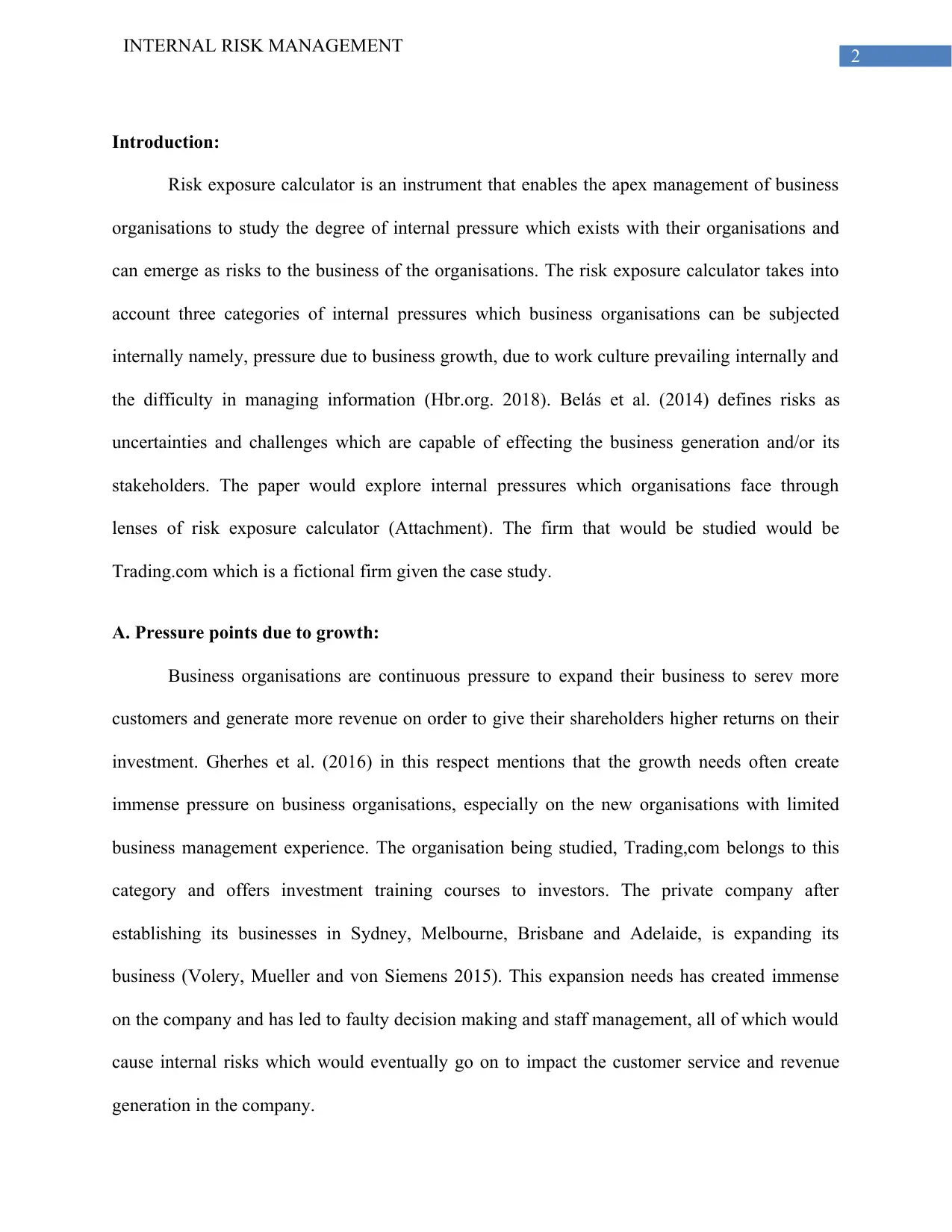
2
INTERNAL RISK MANAGEMENT
Introduction:
Risk exposure calculator is an instrument that enables the apex management of business
organisations to study the degree of internal pressure which exists with their organisations and
can emerge as risks to the business of the organisations. The risk exposure calculator takes into
account three categories of internal pressures which business organisations can be subjected
internally namely, pressure due to business growth, due to work culture prevailing internally and
the difficulty in managing information (Hbr.org. 2018). Belás et al. (2014) defines risks as
uncertainties and challenges which are capable of effecting the business generation and/or its
stakeholders. The paper would explore internal pressures which organisations face through
lenses of risk exposure calculator (Attachment). The firm that would be studied would be
Trading.com which is a fictional firm given the case study.
A. Pressure points due to growth:
Business organisations are continuous pressure to expand their business to serev more
customers and generate more revenue on order to give their shareholders higher returns on their
investment. Gherhes et al. (2016) in this respect mentions that the growth needs often create
immense pressure on business organisations, especially on the new organisations with limited
business management experience. The organisation being studied, Trading,com belongs to this
category and offers investment training courses to investors. The private company after
establishing its businesses in Sydney, Melbourne, Brisbane and Adelaide, is expanding its
business (Volery, Mueller and von Siemens 2015). This expansion needs has created immense
on the company and has led to faulty decision making and staff management, all of which would
cause internal risks which would eventually go on to impact the customer service and revenue
generation in the company.
INTERNAL RISK MANAGEMENT
Introduction:
Risk exposure calculator is an instrument that enables the apex management of business
organisations to study the degree of internal pressure which exists with their organisations and
can emerge as risks to the business of the organisations. The risk exposure calculator takes into
account three categories of internal pressures which business organisations can be subjected
internally namely, pressure due to business growth, due to work culture prevailing internally and
the difficulty in managing information (Hbr.org. 2018). Belás et al. (2014) defines risks as
uncertainties and challenges which are capable of effecting the business generation and/or its
stakeholders. The paper would explore internal pressures which organisations face through
lenses of risk exposure calculator (Attachment). The firm that would be studied would be
Trading.com which is a fictional firm given the case study.
A. Pressure points due to growth:
Business organisations are continuous pressure to expand their business to serev more
customers and generate more revenue on order to give their shareholders higher returns on their
investment. Gherhes et al. (2016) in this respect mentions that the growth needs often create
immense pressure on business organisations, especially on the new organisations with limited
business management experience. The organisation being studied, Trading,com belongs to this
category and offers investment training courses to investors. The private company after
establishing its businesses in Sydney, Melbourne, Brisbane and Adelaide, is expanding its
business (Volery, Mueller and von Siemens 2015). This expansion needs has created immense
on the company and has led to faulty decision making and staff management, all of which would
cause internal risks which would eventually go on to impact the customer service and revenue
generation in the company.
⊘ This is a preview!⊘
Do you want full access?
Subscribe today to unlock all pages.

Trusted by 1+ million students worldwide
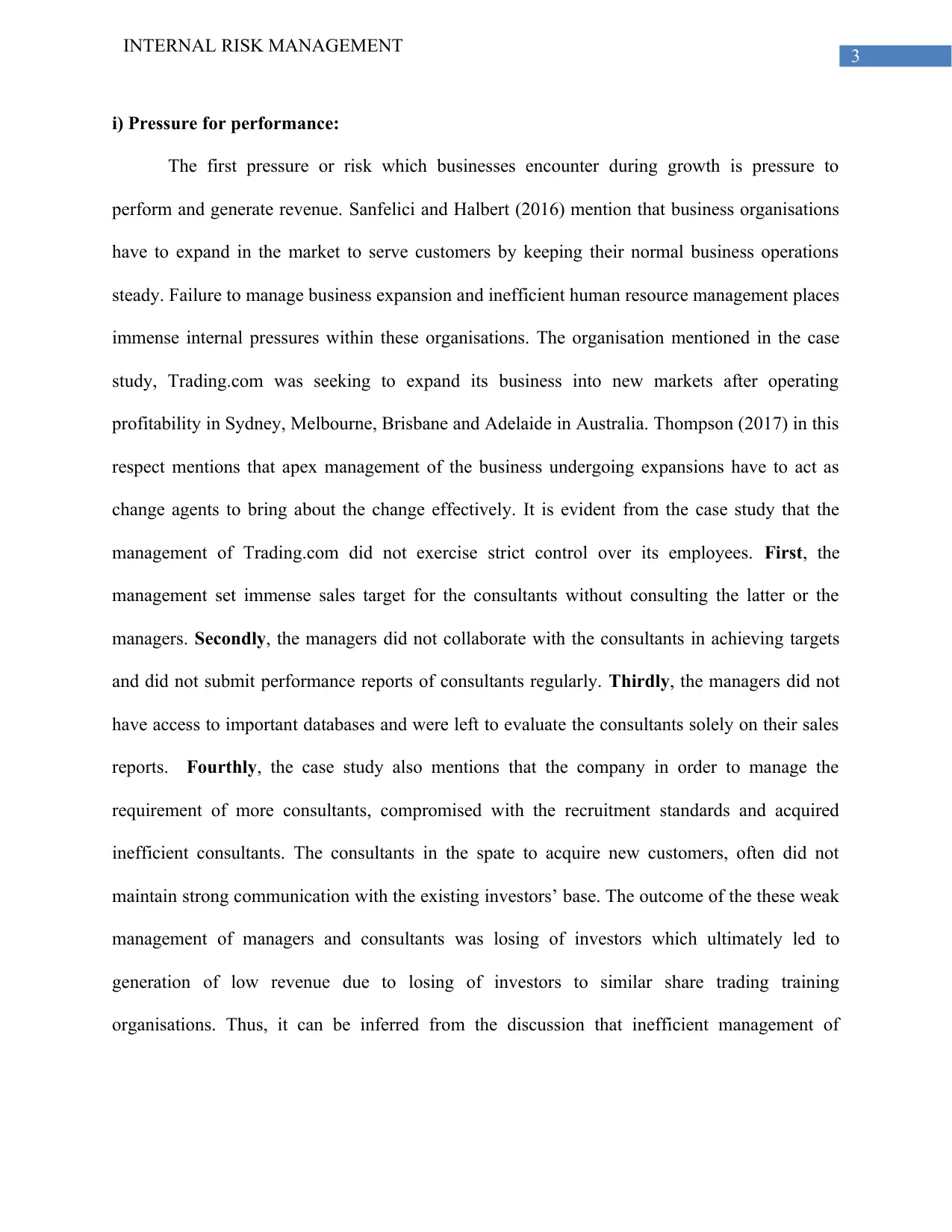
3
INTERNAL RISK MANAGEMENT
i) Pressure for performance:
The first pressure or risk which businesses encounter during growth is pressure to
perform and generate revenue. Sanfelici and Halbert (2016) mention that business organisations
have to expand in the market to serve customers by keeping their normal business operations
steady. Failure to manage business expansion and inefficient human resource management places
immense internal pressures within these organisations. The organisation mentioned in the case
study, Trading.com was seeking to expand its business into new markets after operating
profitability in Sydney, Melbourne, Brisbane and Adelaide in Australia. Thompson (2017) in this
respect mentions that apex management of the business undergoing expansions have to act as
change agents to bring about the change effectively. It is evident from the case study that the
management of Trading.com did not exercise strict control over its employees. First, the
management set immense sales target for the consultants without consulting the latter or the
managers. Secondly, the managers did not collaborate with the consultants in achieving targets
and did not submit performance reports of consultants regularly. Thirdly, the managers did not
have access to important databases and were left to evaluate the consultants solely on their sales
reports. Fourthly, the case study also mentions that the company in order to manage the
requirement of more consultants, compromised with the recruitment standards and acquired
inefficient consultants. The consultants in the spate to acquire new customers, often did not
maintain strong communication with the existing investors’ base. The outcome of the these weak
management of managers and consultants was losing of investors which ultimately led to
generation of low revenue due to losing of investors to similar share trading training
organisations. Thus, it can be inferred from the discussion that inefficient management of
INTERNAL RISK MANAGEMENT
i) Pressure for performance:
The first pressure or risk which businesses encounter during growth is pressure to
perform and generate revenue. Sanfelici and Halbert (2016) mention that business organisations
have to expand in the market to serve customers by keeping their normal business operations
steady. Failure to manage business expansion and inefficient human resource management places
immense internal pressures within these organisations. The organisation mentioned in the case
study, Trading.com was seeking to expand its business into new markets after operating
profitability in Sydney, Melbourne, Brisbane and Adelaide in Australia. Thompson (2017) in this
respect mentions that apex management of the business undergoing expansions have to act as
change agents to bring about the change effectively. It is evident from the case study that the
management of Trading.com did not exercise strict control over its employees. First, the
management set immense sales target for the consultants without consulting the latter or the
managers. Secondly, the managers did not collaborate with the consultants in achieving targets
and did not submit performance reports of consultants regularly. Thirdly, the managers did not
have access to important databases and were left to evaluate the consultants solely on their sales
reports. Fourthly, the case study also mentions that the company in order to manage the
requirement of more consultants, compromised with the recruitment standards and acquired
inefficient consultants. The consultants in the spate to acquire new customers, often did not
maintain strong communication with the existing investors’ base. The outcome of the these weak
management of managers and consultants was losing of investors which ultimately led to
generation of low revenue due to losing of investors to similar share trading training
organisations. Thus, it can be inferred from the discussion that inefficient management of
Paraphrase This Document
Need a fresh take? Get an instant paraphrase of this document with our AI Paraphraser

4
INTERNAL RISK MANAGEMENT
employees and lack of empowerment among them results in poor performance in business
organisations during expansions.
ii) Rate of expansion:
Business organisations should control their business operations strictly to ensure
expansion towards business growth. Bocken and Short (2016) supports Sanfelici and Halbert
(2016) and mention that business expansions create immense pressure on the existing resources.
The business organisations have to acquire more resources to support their expansion. The apex
management and the managers have to ensure proper management of the newly acquired
resources. As far Trading.com is concerned, the management compromised on its recruitment
strategy and recruited consultants without appropriate competencies to handle investors. Jackson,
Schuler and Jiang (2014) in this respect point out that strategic human resource management
plays a very significant role in management of employees including the newly hired to align
them with the business needs. An analysis of the case study in the light of SHRM would point
out that the management of Trading.com unable to manage the expansion of the firm recruited
inefficient consultants. Thus, it can be inferred from the discussion that this inefficient HRM
by the apex management created human resource risk within the organisation,
jeopardising its rate of expansion.
iii) Inexperience of key employees:
Inexperience among key employees, especially the employees offering services directly
to customers or clients can create revenue generation due to lack of satisfaction among the latter.
Boon
INTERNAL RISK MANAGEMENT
employees and lack of empowerment among them results in poor performance in business
organisations during expansions.
ii) Rate of expansion:
Business organisations should control their business operations strictly to ensure
expansion towards business growth. Bocken and Short (2016) supports Sanfelici and Halbert
(2016) and mention that business expansions create immense pressure on the existing resources.
The business organisations have to acquire more resources to support their expansion. The apex
management and the managers have to ensure proper management of the newly acquired
resources. As far Trading.com is concerned, the management compromised on its recruitment
strategy and recruited consultants without appropriate competencies to handle investors. Jackson,
Schuler and Jiang (2014) in this respect point out that strategic human resource management
plays a very significant role in management of employees including the newly hired to align
them with the business needs. An analysis of the case study in the light of SHRM would point
out that the management of Trading.com unable to manage the expansion of the firm recruited
inefficient consultants. Thus, it can be inferred from the discussion that this inefficient HRM
by the apex management created human resource risk within the organisation,
jeopardising its rate of expansion.
iii) Inexperience of key employees:
Inexperience among key employees, especially the employees offering services directly
to customers or clients can create revenue generation due to lack of satisfaction among the latter.
Boon

5
INTERNAL RISK MANAGEMENT
B. Pressure points due to culture:
The business organisations have to face pressure during critical phases like business
expansion if they do not have strong internal employee culture. The following section would
visit the pressures which organisations face due to cultural issues:
i) Rewards for entrepreneurial risk taking:
Entrepreneurs take risks in the business in order to earn high profits and achieve business
growth. Aithal, Shailashree and Kumar (2015) mention that risk acts as a motivating factor for
entrepreneurs to take business risks like competition from similar companies in spite of limited
resources available to them. Santos, Pache and Birkholz (2015) contradict this statement and
mention that the relationship between risk and business profit is not always true. The risk taking
capability and achievement of profit depends on several factors like experience of the
entrepreneur and organisational cultures with the organisations they command. As far as
Trading.com is concerned, it can be pointed that the entrepreneur, Jospe Drake had an experience
of three years. It can be pointed out considering the complex and vast size of the global stock
market that his experience of three years was not sufficient to lead the firm in share market
training business. Further, it can be pointed out that to certain extent due to lack of experience,
Jospe did not concentrate on empower his employees including managers in taking long term
decisions. The management of Trading.com set immense targets for the consultants and the
managers did not collaborate with the latter in achieving the targets. In fact, the managers lacked
access to critical business information. Strong internal rivalry developed among the consultants
to achieve their targets and they did not cooperate with each other. The apex management did not
take any initiative to strengthen cohesion among the employees and was only interested in their
sales achievement. This weak hostile organisational culture prevailing within Trading.com led to
INTERNAL RISK MANAGEMENT
B. Pressure points due to culture:
The business organisations have to face pressure during critical phases like business
expansion if they do not have strong internal employee culture. The following section would
visit the pressures which organisations face due to cultural issues:
i) Rewards for entrepreneurial risk taking:
Entrepreneurs take risks in the business in order to earn high profits and achieve business
growth. Aithal, Shailashree and Kumar (2015) mention that risk acts as a motivating factor for
entrepreneurs to take business risks like competition from similar companies in spite of limited
resources available to them. Santos, Pache and Birkholz (2015) contradict this statement and
mention that the relationship between risk and business profit is not always true. The risk taking
capability and achievement of profit depends on several factors like experience of the
entrepreneur and organisational cultures with the organisations they command. As far as
Trading.com is concerned, it can be pointed that the entrepreneur, Jospe Drake had an experience
of three years. It can be pointed out considering the complex and vast size of the global stock
market that his experience of three years was not sufficient to lead the firm in share market
training business. Further, it can be pointed out that to certain extent due to lack of experience,
Jospe did not concentrate on empower his employees including managers in taking long term
decisions. The management of Trading.com set immense targets for the consultants and the
managers did not collaborate with the latter in achieving the targets. In fact, the managers lacked
access to critical business information. Strong internal rivalry developed among the consultants
to achieve their targets and they did not cooperate with each other. The apex management did not
take any initiative to strengthen cohesion among the employees and was only interested in their
sales achievement. This weak hostile organisational culture prevailing within Trading.com led to
⊘ This is a preview!⊘
Do you want full access?
Subscribe today to unlock all pages.

Trusted by 1+ million students worldwide
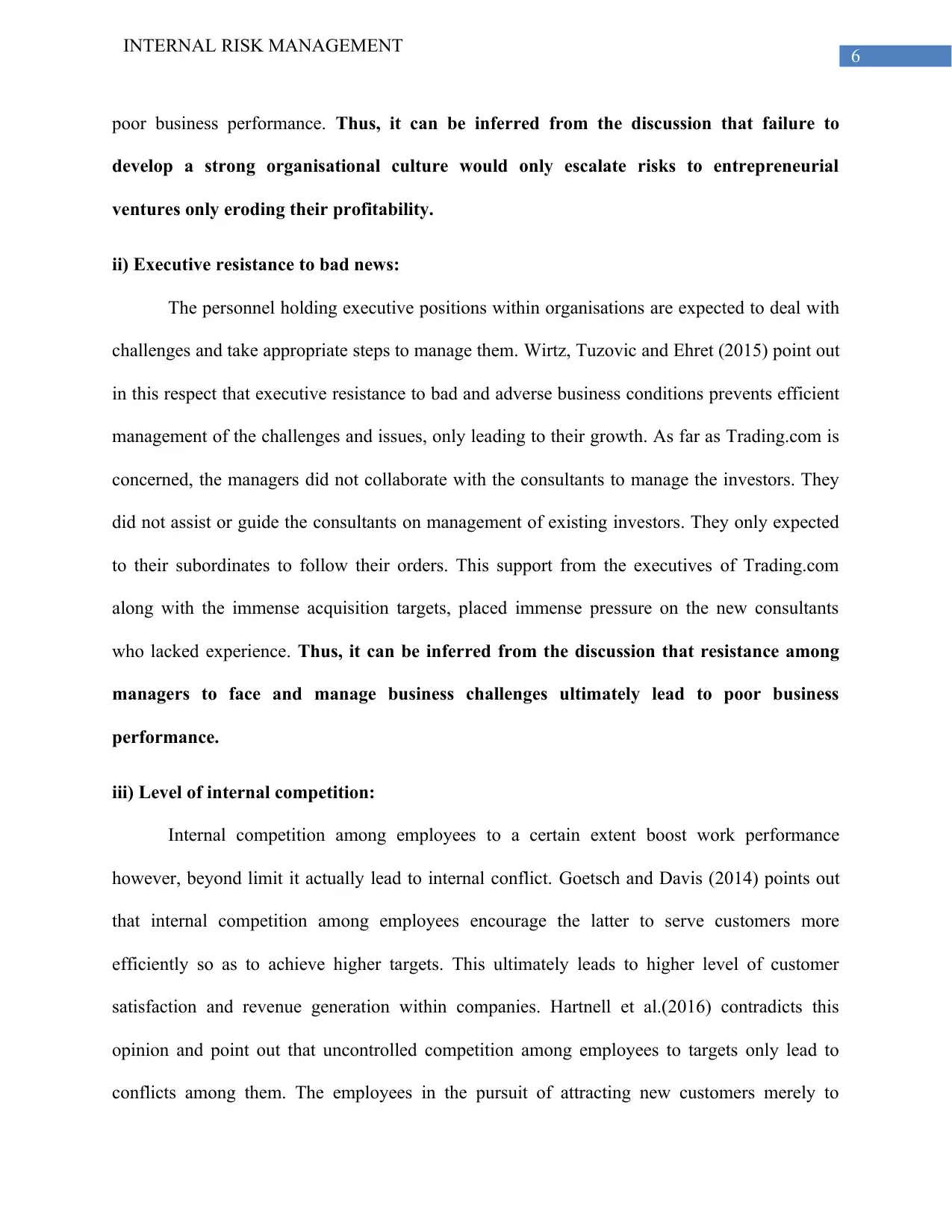
6
INTERNAL RISK MANAGEMENT
poor business performance. Thus, it can be inferred from the discussion that failure to
develop a strong organisational culture would only escalate risks to entrepreneurial
ventures only eroding their profitability.
ii) Executive resistance to bad news:
The personnel holding executive positions within organisations are expected to deal with
challenges and take appropriate steps to manage them. Wirtz, Tuzovic and Ehret (2015) point out
in this respect that executive resistance to bad and adverse business conditions prevents efficient
management of the challenges and issues, only leading to their growth. As far as Trading.com is
concerned, the managers did not collaborate with the consultants to manage the investors. They
did not assist or guide the consultants on management of existing investors. They only expected
to their subordinates to follow their orders. This support from the executives of Trading.com
along with the immense acquisition targets, placed immense pressure on the new consultants
who lacked experience. Thus, it can be inferred from the discussion that resistance among
managers to face and manage business challenges ultimately lead to poor business
performance.
iii) Level of internal competition:
Internal competition among employees to a certain extent boost work performance
however, beyond limit it actually lead to internal conflict. Goetsch and Davis (2014) points out
that internal competition among employees encourage the latter to serve customers more
efficiently so as to achieve higher targets. This ultimately leads to higher level of customer
satisfaction and revenue generation within companies. Hartnell et al.(2016) contradicts this
opinion and point out that uncontrolled competition among employees to targets only lead to
conflicts among them. The employees in the pursuit of attracting new customers merely to
INTERNAL RISK MANAGEMENT
poor business performance. Thus, it can be inferred from the discussion that failure to
develop a strong organisational culture would only escalate risks to entrepreneurial
ventures only eroding their profitability.
ii) Executive resistance to bad news:
The personnel holding executive positions within organisations are expected to deal with
challenges and take appropriate steps to manage them. Wirtz, Tuzovic and Ehret (2015) point out
in this respect that executive resistance to bad and adverse business conditions prevents efficient
management of the challenges and issues, only leading to their growth. As far as Trading.com is
concerned, the managers did not collaborate with the consultants to manage the investors. They
did not assist or guide the consultants on management of existing investors. They only expected
to their subordinates to follow their orders. This support from the executives of Trading.com
along with the immense acquisition targets, placed immense pressure on the new consultants
who lacked experience. Thus, it can be inferred from the discussion that resistance among
managers to face and manage business challenges ultimately lead to poor business
performance.
iii) Level of internal competition:
Internal competition among employees to a certain extent boost work performance
however, beyond limit it actually lead to internal conflict. Goetsch and Davis (2014) points out
that internal competition among employees encourage the latter to serve customers more
efficiently so as to achieve higher targets. This ultimately leads to higher level of customer
satisfaction and revenue generation within companies. Hartnell et al.(2016) contradicts this
opinion and point out that uncontrolled competition among employees to targets only lead to
conflicts among them. The employees in the pursuit of attracting new customers merely to
Paraphrase This Document
Need a fresh take? Get an instant paraphrase of this document with our AI Paraphraser

7
INTERNAL RISK MANAGEMENT
achieve business targets assigned to them often fail to after sales and follow up services to
existing customers. The outcome of this irresponsible customer management only leads to losing
to customers and fall of revenue in the long run. The case study of Trading.com provides a
perfect example in this regard. The management of Trading.com assigned unrealistic business
targets on consultants which created stress on the latter. Further, the managers provided no
support to the consultants in achievement of targets or the employees. The management did not
take any initiative to train the consultants to manage this intense stress which is evident from the
case study. The consultants without no intervention from either the apex management or the
managers, indulged in cut throat competition of acquiring investors. They, in fact did not provide
the existing investors with follow-up service or advice services. Thus, it can be pointed this
hostile internal competition among employees only led to the firm losing its investors. This, it
can be inferred uncontrolled competition among employees (consultants in this case) in
organisation would prove detrimental to their businesses on the long run (Samnani and Singh
2014)
C. Pressure points due to information management:
Business organisations are under perpetual pressure to manage their vast body of
information and in fact align it with their business growth plans. The following section would
stress on the risk which business organisations due to failure to exercise sufficient control over
their respective knowledge capital.
i) Transaction complexity and velocity:
Business organisations have to manage their financial transactions stringently to ensure
their profitability to their respective business processes. Li et al.(2016) in this respect that
business organisations today indulge such huge volume of transactions right from making
INTERNAL RISK MANAGEMENT
achieve business targets assigned to them often fail to after sales and follow up services to
existing customers. The outcome of this irresponsible customer management only leads to losing
to customers and fall of revenue in the long run. The case study of Trading.com provides a
perfect example in this regard. The management of Trading.com assigned unrealistic business
targets on consultants which created stress on the latter. Further, the managers provided no
support to the consultants in achievement of targets or the employees. The management did not
take any initiative to train the consultants to manage this intense stress which is evident from the
case study. The consultants without no intervention from either the apex management or the
managers, indulged in cut throat competition of acquiring investors. They, in fact did not provide
the existing investors with follow-up service or advice services. Thus, it can be pointed this
hostile internal competition among employees only led to the firm losing its investors. This, it
can be inferred uncontrolled competition among employees (consultants in this case) in
organisation would prove detrimental to their businesses on the long run (Samnani and Singh
2014)
C. Pressure points due to information management:
Business organisations are under perpetual pressure to manage their vast body of
information and in fact align it with their business growth plans. The following section would
stress on the risk which business organisations due to failure to exercise sufficient control over
their respective knowledge capital.
i) Transaction complexity and velocity:
Business organisations have to manage their financial transactions stringently to ensure
their profitability to their respective business processes. Li et al.(2016) in this respect that
business organisations today indulge such huge volume of transactions right from making

8
INTERNAL RISK MANAGEMENT
payments to creditors, receiving payments from debtors to paying salaries to employees that it
has become very important to keep timely record of all these transactions. This fact is even more
applicable in case of Trading.com since the company operates in the stock market. Arthur (2018)
mentions that the returns in stock markets are subjected to several external factors like financial
laws and economic conditions. Adam, Marcet and Nicolini (2016) further enriches this
discussion by mentioning that the stock market is highly volatile and subject to both bearish and
bullish trends. However, the high returns which stock market gives, which is far more compared
to the secured investments like money market instruments, attracts immense number of investors.
Chaibi, Alioui and Xiao (2015) further point out that the stock market is subject to financial
transactions worth billions. Thus, in this respect it can be pointed out that the failure of
Trading.com consultants to provide the investors timely advice led to losing its investors to other
firms. This it can be inferred that failure to provide timely services in complex and high velocity
bundled with poor information management would lead to losing of customers and business loss
worth millions.
ii) Gaps in diagnostic performance:
The apex management should daignose the gaps within the organisations like extreme
hostile professional relationship among consultants or employees to achieve targets. The
managers should take appropriate steps to control and diagnose the issues to prevent future
recurrence. As far as the management of Trading.com is concerned, the management did not take
any step to control and minimise the internal hostilities among employees. This ultimately led to
poor investors service and business losses.
INTERNAL RISK MANAGEMENT
payments to creditors, receiving payments from debtors to paying salaries to employees that it
has become very important to keep timely record of all these transactions. This fact is even more
applicable in case of Trading.com since the company operates in the stock market. Arthur (2018)
mentions that the returns in stock markets are subjected to several external factors like financial
laws and economic conditions. Adam, Marcet and Nicolini (2016) further enriches this
discussion by mentioning that the stock market is highly volatile and subject to both bearish and
bullish trends. However, the high returns which stock market gives, which is far more compared
to the secured investments like money market instruments, attracts immense number of investors.
Chaibi, Alioui and Xiao (2015) further point out that the stock market is subject to financial
transactions worth billions. Thus, in this respect it can be pointed out that the failure of
Trading.com consultants to provide the investors timely advice led to losing its investors to other
firms. This it can be inferred that failure to provide timely services in complex and high velocity
bundled with poor information management would lead to losing of customers and business loss
worth millions.
ii) Gaps in diagnostic performance:
The apex management should daignose the gaps within the organisations like extreme
hostile professional relationship among consultants or employees to achieve targets. The
managers should take appropriate steps to control and diagnose the issues to prevent future
recurrence. As far as the management of Trading.com is concerned, the management did not take
any step to control and minimise the internal hostilities among employees. This ultimately led to
poor investors service and business losses.
⊘ This is a preview!⊘
Do you want full access?
Subscribe today to unlock all pages.

Trusted by 1+ million students worldwide
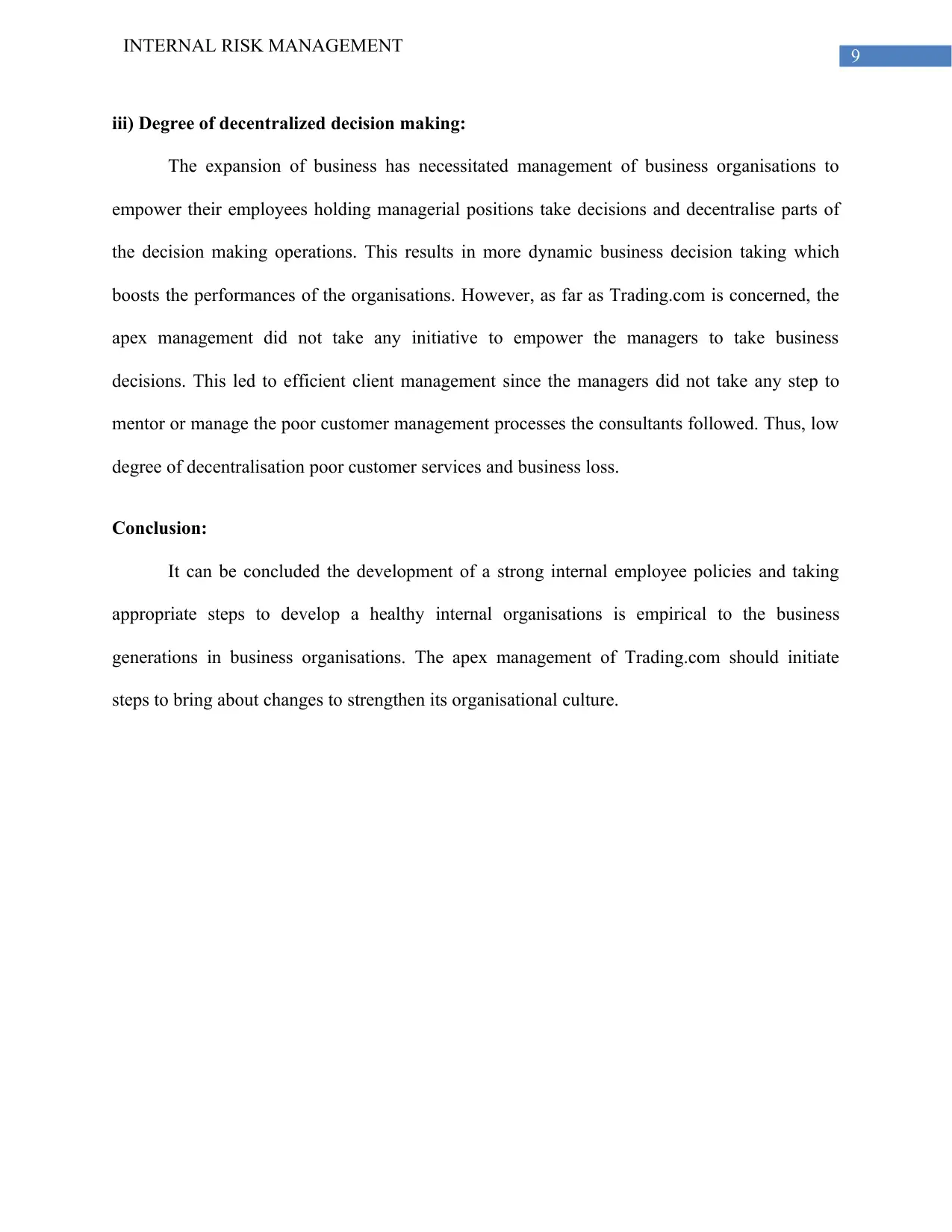
9
INTERNAL RISK MANAGEMENT
iii) Degree of decentralized decision making:
The expansion of business has necessitated management of business organisations to
empower their employees holding managerial positions take decisions and decentralise parts of
the decision making operations. This results in more dynamic business decision taking which
boosts the performances of the organisations. However, as far as Trading.com is concerned, the
apex management did not take any initiative to empower the managers to take business
decisions. This led to efficient client management since the managers did not take any step to
mentor or manage the poor customer management processes the consultants followed. Thus, low
degree of decentralisation poor customer services and business loss.
Conclusion:
It can be concluded the development of a strong internal employee policies and taking
appropriate steps to develop a healthy internal organisations is empirical to the business
generations in business organisations. The apex management of Trading.com should initiate
steps to bring about changes to strengthen its organisational culture.
INTERNAL RISK MANAGEMENT
iii) Degree of decentralized decision making:
The expansion of business has necessitated management of business organisations to
empower their employees holding managerial positions take decisions and decentralise parts of
the decision making operations. This results in more dynamic business decision taking which
boosts the performances of the organisations. However, as far as Trading.com is concerned, the
apex management did not take any initiative to empower the managers to take business
decisions. This led to efficient client management since the managers did not take any step to
mentor or manage the poor customer management processes the consultants followed. Thus, low
degree of decentralisation poor customer services and business loss.
Conclusion:
It can be concluded the development of a strong internal employee policies and taking
appropriate steps to develop a healthy internal organisations is empirical to the business
generations in business organisations. The apex management of Trading.com should initiate
steps to bring about changes to strengthen its organisational culture.
Paraphrase This Document
Need a fresh take? Get an instant paraphrase of this document with our AI Paraphraser
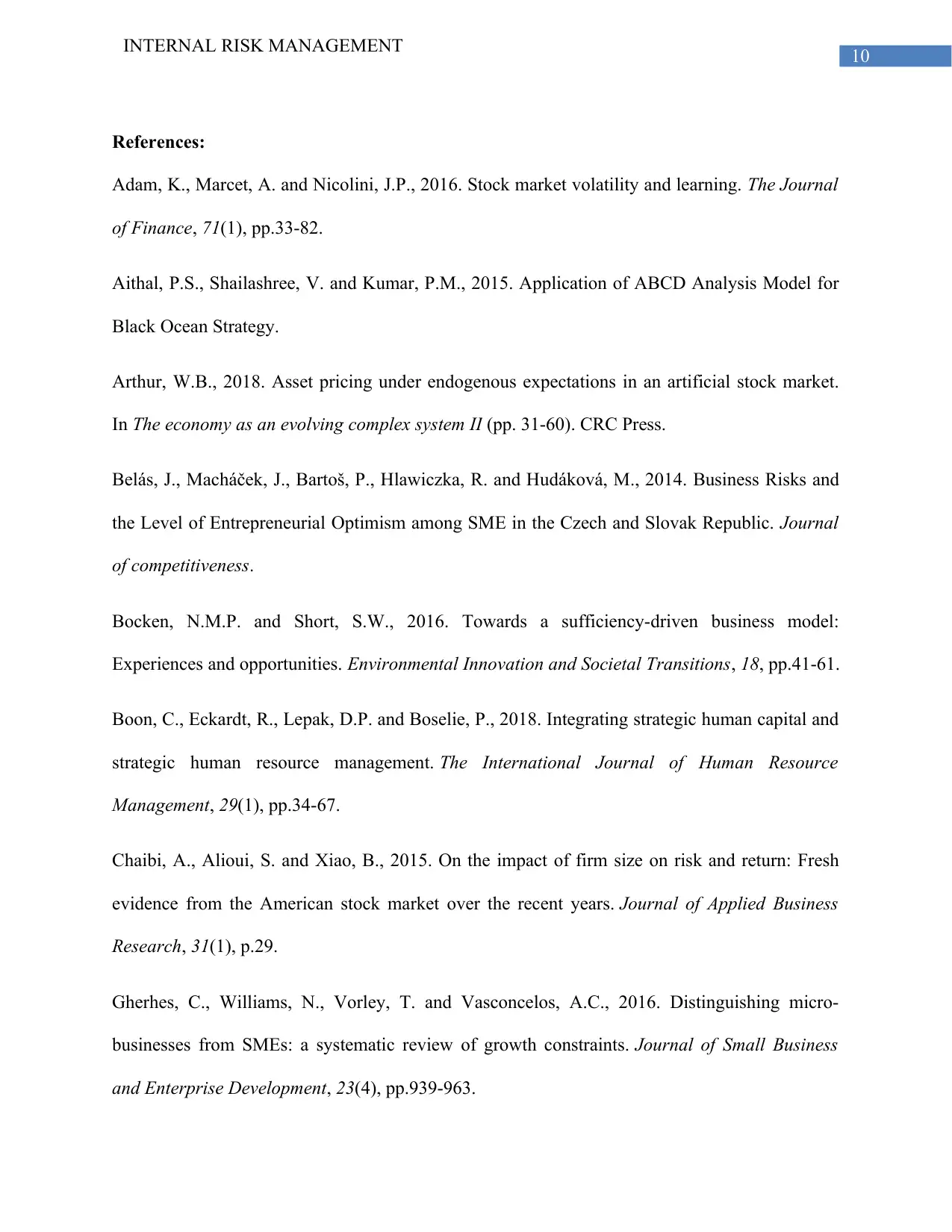
10
INTERNAL RISK MANAGEMENT
References:
Adam, K., Marcet, A. and Nicolini, J.P., 2016. Stock market volatility and learning. The Journal
of Finance, 71(1), pp.33-82.
Aithal, P.S., Shailashree, V. and Kumar, P.M., 2015. Application of ABCD Analysis Model for
Black Ocean Strategy.
Arthur, W.B., 2018. Asset pricing under endogenous expectations in an artificial stock market.
In The economy as an evolving complex system II (pp. 31-60). CRC Press.
Belás, J., Macháček, J., Bartoš, P., Hlawiczka, R. and Hudáková, M., 2014. Business Risks and
the Level of Entrepreneurial Optimism among SME in the Czech and Slovak Republic. Journal
of competitiveness.
Bocken, N.M.P. and Short, S.W., 2016. Towards a sufficiency-driven business model:
Experiences and opportunities. Environmental Innovation and Societal Transitions, 18, pp.41-61.
Boon, C., Eckardt, R., Lepak, D.P. and Boselie, P., 2018. Integrating strategic human capital and
strategic human resource management. The International Journal of Human Resource
Management, 29(1), pp.34-67.
Chaibi, A., Alioui, S. and Xiao, B., 2015. On the impact of firm size on risk and return: Fresh
evidence from the American stock market over the recent years. Journal of Applied Business
Research, 31(1), p.29.
Gherhes, C., Williams, N., Vorley, T. and Vasconcelos, A.C., 2016. Distinguishing micro-
businesses from SMEs: a systematic review of growth constraints. Journal of Small Business
and Enterprise Development, 23(4), pp.939-963.
INTERNAL RISK MANAGEMENT
References:
Adam, K., Marcet, A. and Nicolini, J.P., 2016. Stock market volatility and learning. The Journal
of Finance, 71(1), pp.33-82.
Aithal, P.S., Shailashree, V. and Kumar, P.M., 2015. Application of ABCD Analysis Model for
Black Ocean Strategy.
Arthur, W.B., 2018. Asset pricing under endogenous expectations in an artificial stock market.
In The economy as an evolving complex system II (pp. 31-60). CRC Press.
Belás, J., Macháček, J., Bartoš, P., Hlawiczka, R. and Hudáková, M., 2014. Business Risks and
the Level of Entrepreneurial Optimism among SME in the Czech and Slovak Republic. Journal
of competitiveness.
Bocken, N.M.P. and Short, S.W., 2016. Towards a sufficiency-driven business model:
Experiences and opportunities. Environmental Innovation and Societal Transitions, 18, pp.41-61.
Boon, C., Eckardt, R., Lepak, D.P. and Boselie, P., 2018. Integrating strategic human capital and
strategic human resource management. The International Journal of Human Resource
Management, 29(1), pp.34-67.
Chaibi, A., Alioui, S. and Xiao, B., 2015. On the impact of firm size on risk and return: Fresh
evidence from the American stock market over the recent years. Journal of Applied Business
Research, 31(1), p.29.
Gherhes, C., Williams, N., Vorley, T. and Vasconcelos, A.C., 2016. Distinguishing micro-
businesses from SMEs: a systematic review of growth constraints. Journal of Small Business
and Enterprise Development, 23(4), pp.939-963.
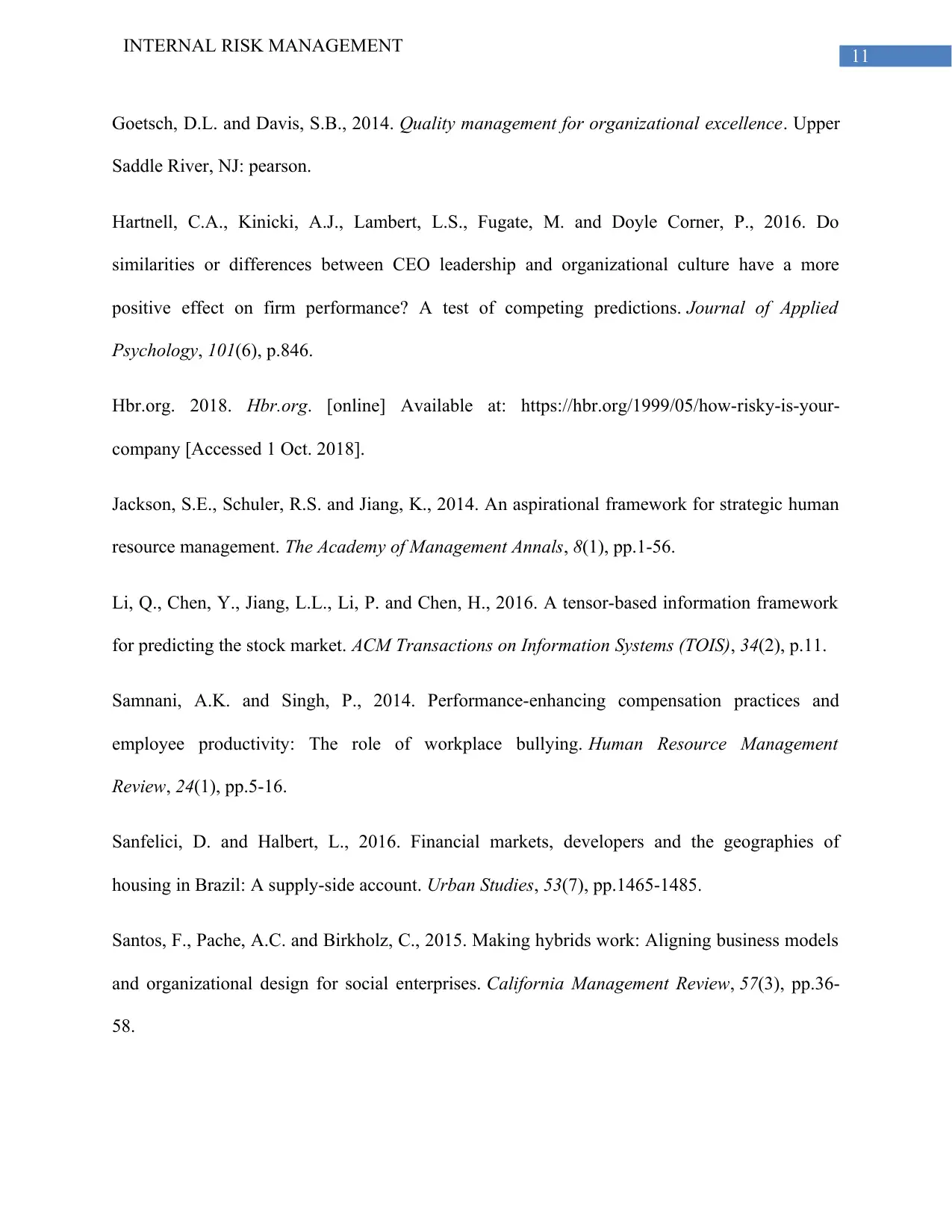
11
INTERNAL RISK MANAGEMENT
Goetsch, D.L. and Davis, S.B., 2014. Quality management for organizational excellence. Upper
Saddle River, NJ: pearson.
Hartnell, C.A., Kinicki, A.J., Lambert, L.S., Fugate, M. and Doyle Corner, P., 2016. Do
similarities or differences between CEO leadership and organizational culture have a more
positive effect on firm performance? A test of competing predictions. Journal of Applied
Psychology, 101(6), p.846.
Hbr.org. 2018. Hbr.org. [online] Available at: https://hbr.org/1999/05/how-risky-is-your-
company [Accessed 1 Oct. 2018].
Jackson, S.E., Schuler, R.S. and Jiang, K., 2014. An aspirational framework for strategic human
resource management. The Academy of Management Annals, 8(1), pp.1-56.
Li, Q., Chen, Y., Jiang, L.L., Li, P. and Chen, H., 2016. A tensor-based information framework
for predicting the stock market. ACM Transactions on Information Systems (TOIS), 34(2), p.11.
Samnani, A.K. and Singh, P., 2014. Performance-enhancing compensation practices and
employee productivity: The role of workplace bullying. Human Resource Management
Review, 24(1), pp.5-16.
Sanfelici, D. and Halbert, L., 2016. Financial markets, developers and the geographies of
housing in Brazil: A supply-side account. Urban Studies, 53(7), pp.1465-1485.
Santos, F., Pache, A.C. and Birkholz, C., 2015. Making hybrids work: Aligning business models
and organizational design for social enterprises. California Management Review, 57(3), pp.36-
58.
INTERNAL RISK MANAGEMENT
Goetsch, D.L. and Davis, S.B., 2014. Quality management for organizational excellence. Upper
Saddle River, NJ: pearson.
Hartnell, C.A., Kinicki, A.J., Lambert, L.S., Fugate, M. and Doyle Corner, P., 2016. Do
similarities or differences between CEO leadership and organizational culture have a more
positive effect on firm performance? A test of competing predictions. Journal of Applied
Psychology, 101(6), p.846.
Hbr.org. 2018. Hbr.org. [online] Available at: https://hbr.org/1999/05/how-risky-is-your-
company [Accessed 1 Oct. 2018].
Jackson, S.E., Schuler, R.S. and Jiang, K., 2014. An aspirational framework for strategic human
resource management. The Academy of Management Annals, 8(1), pp.1-56.
Li, Q., Chen, Y., Jiang, L.L., Li, P. and Chen, H., 2016. A tensor-based information framework
for predicting the stock market. ACM Transactions on Information Systems (TOIS), 34(2), p.11.
Samnani, A.K. and Singh, P., 2014. Performance-enhancing compensation practices and
employee productivity: The role of workplace bullying. Human Resource Management
Review, 24(1), pp.5-16.
Sanfelici, D. and Halbert, L., 2016. Financial markets, developers and the geographies of
housing in Brazil: A supply-side account. Urban Studies, 53(7), pp.1465-1485.
Santos, F., Pache, A.C. and Birkholz, C., 2015. Making hybrids work: Aligning business models
and organizational design for social enterprises. California Management Review, 57(3), pp.36-
58.
⊘ This is a preview!⊘
Do you want full access?
Subscribe today to unlock all pages.

Trusted by 1+ million students worldwide
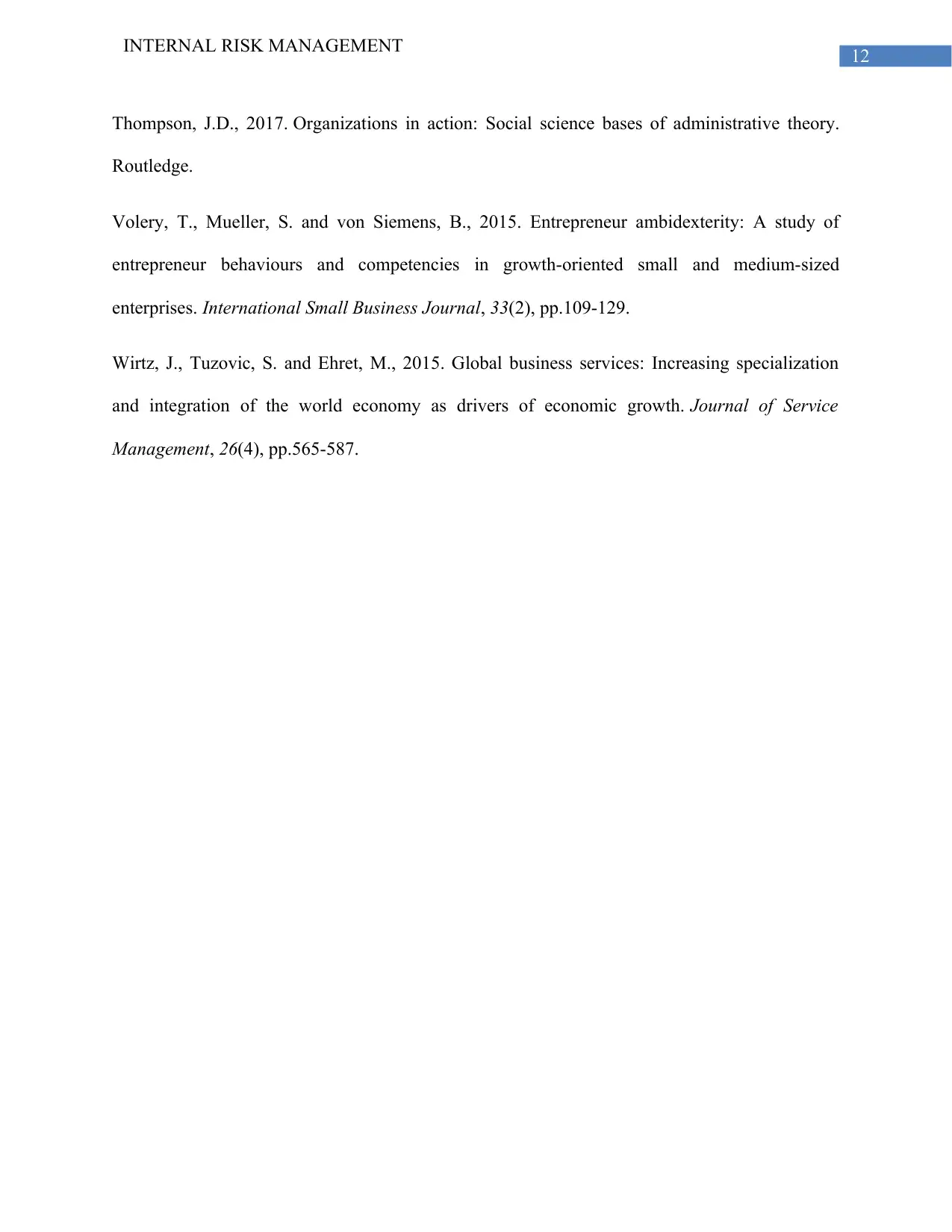
12
INTERNAL RISK MANAGEMENT
Thompson, J.D., 2017. Organizations in action: Social science bases of administrative theory.
Routledge.
Volery, T., Mueller, S. and von Siemens, B., 2015. Entrepreneur ambidexterity: A study of
entrepreneur behaviours and competencies in growth-oriented small and medium-sized
enterprises. International Small Business Journal, 33(2), pp.109-129.
Wirtz, J., Tuzovic, S. and Ehret, M., 2015. Global business services: Increasing specialization
and integration of the world economy as drivers of economic growth. Journal of Service
Management, 26(4), pp.565-587.
INTERNAL RISK MANAGEMENT
Thompson, J.D., 2017. Organizations in action: Social science bases of administrative theory.
Routledge.
Volery, T., Mueller, S. and von Siemens, B., 2015. Entrepreneur ambidexterity: A study of
entrepreneur behaviours and competencies in growth-oriented small and medium-sized
enterprises. International Small Business Journal, 33(2), pp.109-129.
Wirtz, J., Tuzovic, S. and Ehret, M., 2015. Global business services: Increasing specialization
and integration of the world economy as drivers of economic growth. Journal of Service
Management, 26(4), pp.565-587.
1 out of 13
Related Documents
Your All-in-One AI-Powered Toolkit for Academic Success.
+13062052269
info@desklib.com
Available 24*7 on WhatsApp / Email
![[object Object]](/_next/static/media/star-bottom.7253800d.svg)
Unlock your academic potential
© 2024 | Zucol Services PVT LTD | All rights reserved.

